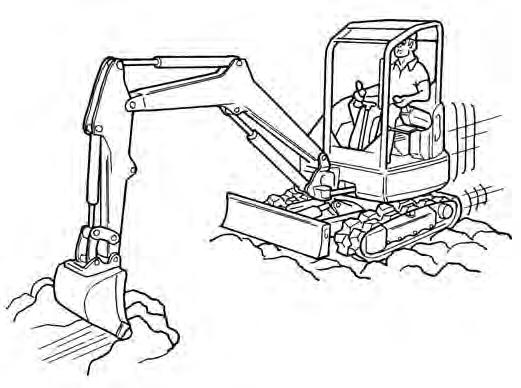
4 minute read
OPERATING PROCEDURE (CONT’D)
Backfilling
Important
Avoid impacting objects with the blade. Damage to blade and undercarriage components may occur.
I-2256-0507
Driving The Excavator
When operating on uneven ground, operate as slow as possible and avoid sudden changes in direction.
Avoid travelling over objects such as rocks, trees, stumps, etc.
When working on wet or soft ground, put planks on the ground to provide a solid base to travel on and prevent the excavator from getting stuck.
Use the blade to backfill the trench or hole after excavating [Figure 145]
If one or both tracks have become stuck in soft or wet ground, raise one track at a time by turning the upperstructure and pushing the bucket against the ground [Figure 146].
Put planks under the tracks and drive the excavator to dry ground.
The bucket may also be used to pull the excavator. Raise the blade, extend the arm and lower the boom. Operate the boom and arm in a digging manner [Figure 147]
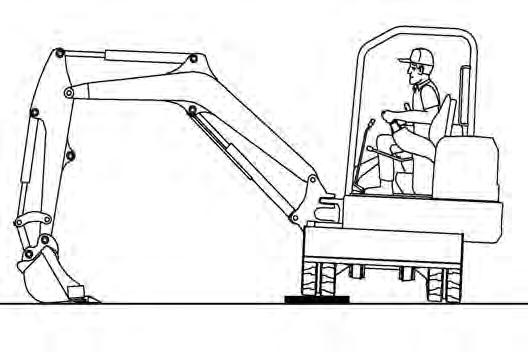

OPERATING PROCEDURE (CONT’D)
Operating On Slopes
Warning
AVOID INJURY OR DEATH
•Do not travel across or up slopes that are over 15 degrees.
•Do not travel down or back up slopes that exceed 25 degrees.
•Look in the direction of travel.
W-2497-0304
When going down a slope, control the speed with the steering levers and the speed control lever.

Warning
AVOID INJURY OR DEATH
•Avoid steep areas or banks that could break away.
•Keep boom centred and attachments as low as possible when travelling on slopes or in rough conditions. Look in the direction of travel.
•Always fasten seat belt.
When going down grades that exceed 15 degrees, put the machine in the position shown, and run the engine slowly [Figure 148]
Operate as slow as possible and avoid sudden changes in lever direction.

Avoid travelling over objects such as rocks, trees, stumps, etc.
Stop the machine before moving the upper equipment controls. Never allow the blade to strike a solid object. Damage to the blade or hydraulic cylinder can result.
When travelling up slopes or on side slopes that are 15 degrees or less, position the machine as shown and run the engine slow [Figure 149] and [Figure 150]

OPERATING PROCEDURE (CONT’D)
Operating On Slopes (Cont’d)
When operating on a slope, level the work area before beginning [Figure 151]
If this is not possible, the following procedures should be used:
Do not work on slopes which are over 15 degrees. Use a slow work cycle.
Avoid working with the tracks across the slope. This will reduce stability and increase the tendency for the machine to slide. Position the excavator with the blade downhill and lowered.
Avoid swinging or extending the bucket more than necessar y in a down hill direction. When you must swing the bucket downhill, keep the arm low and skid the bucket downhill.
When working with the bucket on the uphill side, keep the bucket as close to the ground as possible. Dump the spoil far enough away from the trench or hole to prevent the possibility of a cave in.
To brake the machine when going down a slope, move the steering levers (Item 1) [Figure 152] to the NEUTRAL position. This will engage the hydrostatic braking.

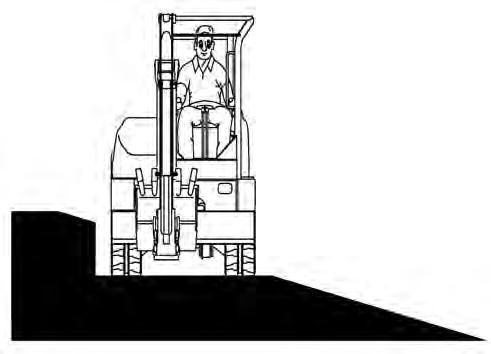
When the engine stops on a slope, move the steering levers to the NEUTRAL position. Lower the boom / bucket to the ground.
NOTE: If the engine stops, the boom / bucket (attachments) can be lowered to the ground using hydraulic pressure which is stored in the accumulator.
The console must be in the locked down position, and the key switch in the ON position.
Use the control lever to lower the boom.
Start the engine and resume operation.
OPERATING PROCEDURE (CONT’D)
Operating In Water
Mud and water should be removed from the machine before parking. In freezing temperatures, park the machine on boards or concrete to prevent the track or undercarriage from freezing to the ground and preventing machine movement.
Maximum Water Level
Do not operate or immerse the excavator in water higher than the bottom of the swing bearing [Figure 153]
Grease the excavator when it has been operated or immersed in water for a period of time. Greasing forces the water out of the lubrication areas.
Water must be removed from the cylinder rods. If water freezes to the cylinder rod, the cylinder seals can be damaged when the rod is retracted.
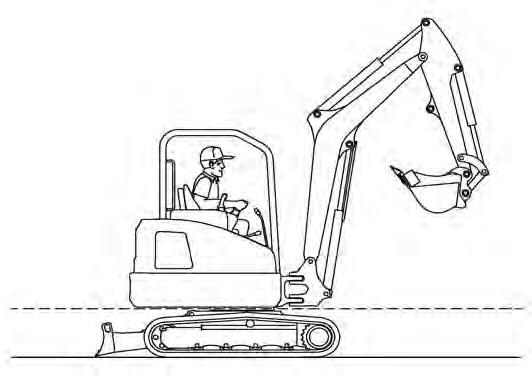
OPERATING PROCEDURE (CONT’D)
Avoiding Track Damage
Mud and water should be removed from the machine before parking. In freezing temperatures, park the machine on boards or concrete to prevent the track or undercarriage from freezing to the ground and preventing machine movement.
Some Cause Of Track Damage:
Incorrect track tension: When the rubber track is detracting, the idler or sprocket rides on the projections of the embedded metal [Figure 154] causing the embedded metal to be exposed to corrosion. (See TRACK TENSION on Page 139.)
If rubber track is clogged with stones or foreign objects, these can get wedged between the sprocket / rollers and cause detracting and track stress.
When moisture invades through cuts on the track, the embedded steel cords will corrode. The deterioration of the design strength may lead to the breaking of the steel cords.
Cuts
When rubber tracks drive over projections or sharp objects in the field, the concentrated forces applied cause cuts on the lug side rubber surface [Figure 155]. In case of making turns on projections, the lug side rubber surface will have an even higher chance to be cut. If the cuts run through the embedded steel cords, it might result in the steel cords' breakage due to their corrosion.

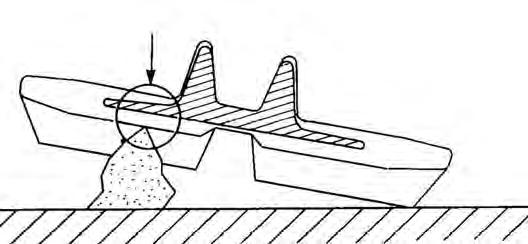

Avoid quick turns on bumpy and rocky fields.
Driving over sharp objects should be avoided. If this is impossible, do not make turns while driving over sharp objects.
When rubber tracks drive over sharp projections, intensive stress is applied to the lug side rubber surface, especially at the edges of embedded metals, causing cracks and cuts in the area around the embedded metals [Figure 156]
Avoid extensive stress applied to the lug root where metals are embedded. Operators should try to avoid driving over stumps and ridges.










